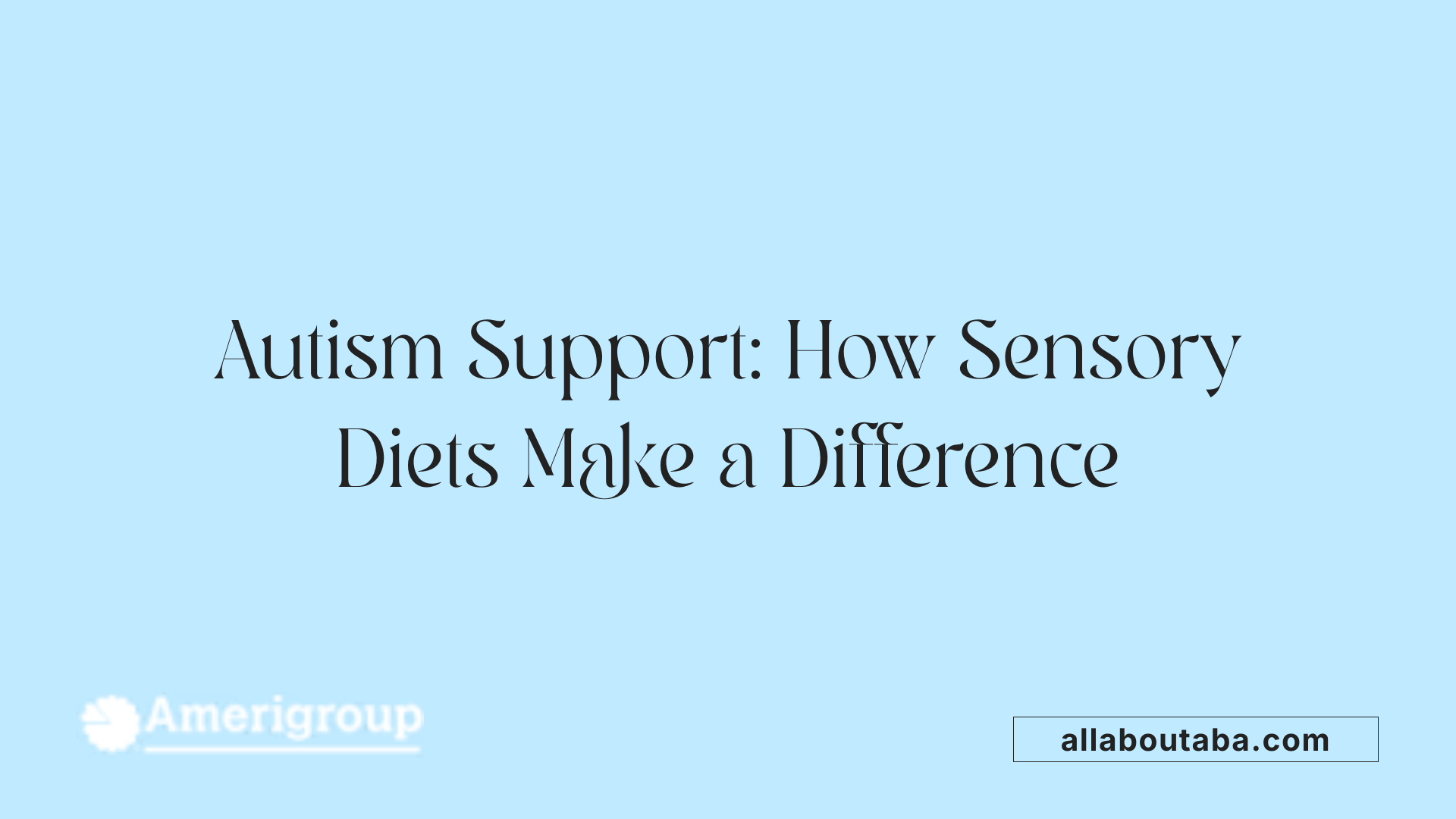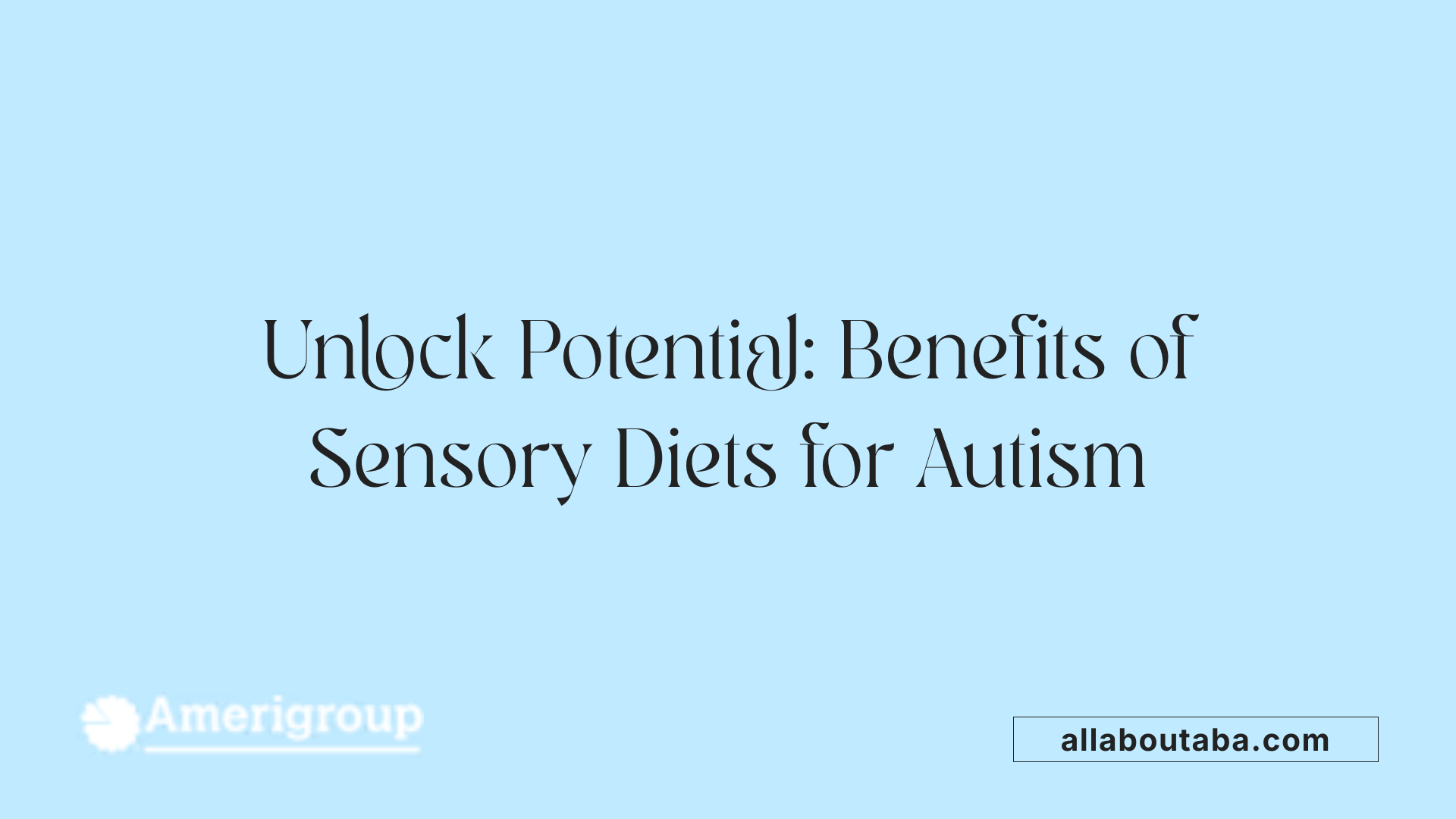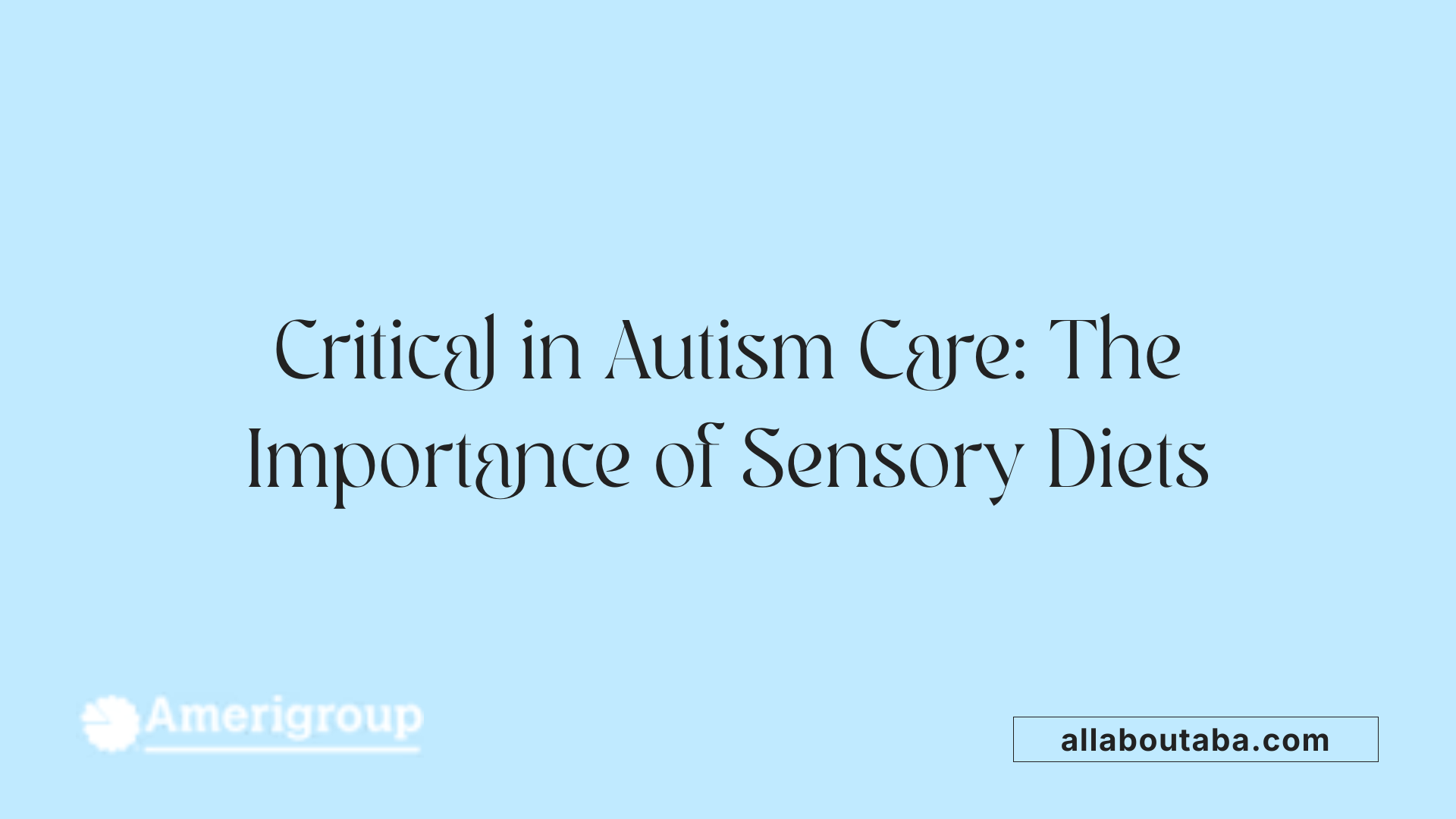Sensory Diets And Their Benefits For Autism Management
Understanding Sensory Diets and Their Role in Autism
Sensory diets are personalized, structured plans designed to help individuals manage their sensory processing difficulties. Developed by occupational therapists, these plans incorporate specific activities and accommodations tailored to meet sensory needs. They aim to promote regulation, reduce sensory overload, and foster engagement in daily routines, especially beneficial for children with autism. This article explores the concept of sensory diets, their benefits, scientific evidence, and effective implementation strategies to support individuals with autism in leading more balanced and fulfilling lives.
What is a Sensory Diet?

What is a sensory diet?
A sensory diet is a customized activity plan designed to help individuals manage their sensory processing needs. Developed by occupational therapists, it includes sensory-motor exercises, calming techniques, and accommodations aimed at regulating the nervous system. The primary goal is to help the person stay alert and calm, avoiding either sensory overload or under-responsiveness.
These plans are tailored to each person’s specific sensory sensitivities and challenges, age, and daily routines. For example, children with autism may experience heightened sensitivity to sounds, textures, or movement. A sensory diet helps them achieve better focus, social interaction, and emotional regulation.
It can be implemented at home, in school, or during therapy sessions. The activities last for an extended period and are intended to maintain a steady, organized sensory state. This proactive approach supports overall functioning and well-being.
Activities involved in sensory diets
Activities are grouped based on sensory systems, including touch, proprioception, vestibular, auditory, visual, smell, and taste. Tailoring activities for each sensory domain helps address specific needs.
Examples of sensory diet activities:
- Proprioceptive activities: Lifting, pushing, or pulling heavy objects, such as carrying a backpack, or playing hopscotch.
- Vestibular activities: Movement-based play like swinging, spinning, or jumping.
- Tactile activities: Touching different textures through drawing in sand or salt, or playing with therapy putty.
- Auditory activities: Listening to calming music or nature sounds, or using noise-canceling headphones.
- Visual strategies: Organizing spaces, reducing visual clutter to support focus.
- Smell activities: Exploring scents that are calming or alerting, and avoiding scents if they cause discomfort.
- Taste activities: Trying different flavors or involving children in food preparations.
These activities aim to either calm an overactive nervous system or provide alerting stimulation for under-responsive individuals.
Role of occupational therapists in creating sensory diets
Occupational therapists are essential in designing and adjusting sensory diets. They conduct assessments to understand an individual’s sensory profile and influence behaviors related to sensory sensitivities.
Therapists tailor activities based on specific sensory needs, and they monitor changes to refine the plan. They also educate caregivers and teachers to implement the activities correctly, ensuring consistency and safety.
Developing an effective sensory diet involves understanding the person’s unique triggers and preferences. Ongoing collaboration with a trained therapist ensures the plan remains responsive to evolving needs.
Overall, sensory diets are a proactive, personalized tool that promotes emotional stability, attention, and social skills, especially for children with sensory processing challenges or autism spectrum disorder.
Role of Sensory Diets in Autism Management

Managing sensory overload in autism
Individuals with autism often experience heightened sensitivity or hyposensitivity to sensory stimuli, which can lead to overwhelming feelings or sensory overload. Sensory diets help mitigate these challenges by providing controlled, intentional sensory input tailored to the person's specific needs. These routines can prevent overstimulation and help individuals feel more in control of their sensory experiences.
How sensory diets assist in emotional and behavioral regulation
A well-structured sensory diet can significantly improve emotional stability and reduce anxiety. By engaging in activities that fulfill sensory needs, children and adults can achieve a calmer state, enabling better self-regulation. For example, calming tactile activities like massage or using weighted blankets can soothe an overexcited nervous system, while alerting activities like jumping or swinging can boost under-responsive individuals.
Importance of individualized planning
Creating an effective sensory diet requires careful assessment of the individual's sensory profile, preferably conducted by an occupational therapist. Personalized plans incorporate a mix of sensory activities—such as tactile play, vestibular movement, or proprioceptive exercises like pushing heavy objects—that align with the person's specific sensitivities. Implementing these tailored activities consistently in daily routines enhances focus, behavior, and social interactions, supporting independence and well-being.
| System | Example Activities | Purpose |
|---|---|---|
| Proprioception | Carrying objects, heavy work, pushing | Seeks body awareness, calming or alerting |
| Vestibular | Swinging, bouncing, spinning | Regulates balance and arousal levels |
| Tactile | Drawing in sand, textured materials | Provides calming touch or sensory input |
| Auditory | Listening to music, noise-canceling headphones | Manages auditory sensitivities |
| Visual | Organizing spaces, visual schedules | Reduces visual clutter and overwhelm |
| Smell | Exploring calming scents | Promotes relaxation and alertness |
| Taste | Trying different flavors, food prep | Supports oral sensory development |
Overall, sensory diets are a valuable component of autism management. They are most effective when customized and implemented under the guidance of an occupational therapist, ensuring activities meet individual needs and promote emotional, behavioral, and functional improvements.
Benefits of Sensory Diets for Individuals with Autism

What are the benefits of sensory diets for individuals with autism?
Sensory diets provide significant advantages for individuals on the autism spectrum by helping them better navigate sensory processing difficulties. One of the primary benefits is the improvement in emotional regulation. Children and adults who engage in personalized sensory activities often experience greater calmness and self-control, which can reduce behaviors associated with frustration or agitation.
Reducing sensory overload is another critical advantage. Many individuals with autism are hypersensitive to stimuli such as sounds, touch, or visual input. Sensory diets help manage this overload by offering targeted sensory input that either calms the nervous system or encourages alertness, depending on individual needs. This organization of sensory input can lessen feelings of anxiety and prevent meltdowns.
Furthermore, sensory diets support enhanced focus and attention. Regular engagement in activities like tactile play, vestibular movement, or auditory calming sounds helps individuals stay organized and attentive during daily routines, including school and social interactions. By providing consistent sensory input, these plans assist in maintaining optimal arousal levels, which is essential for learning and social engagement.
Additionally, overall well-being is promoted through improved sensory integration. When sensory needs are met through tailored activities—such as swinging, drawing in sand, or listening to calming music—individuals often display better motor skills, improved social interactions, and increased participation in everyday activities. This holistic approach fosters independence, emotional stability, and a higher quality of life.
In summary, sensory diets crafted with guidance from occupational therapists help individuals with autism by reducing distress, supporting focus, and promoting emotional and social development. This tailored sensory input enables a more organized, self-regulated, and fulfilling daily experience.
Implementing Sensory Diets Effectively
How can sensory diets be implemented effectively?
Successful implementation of a sensory diet starts with a comprehensive assessment to understand an individual's unique sensory preferences, sensitivities, and triggers. This assessment is ideally carried out by an occupational therapist who specializes in sensory processing. They evaluate which sensory systems—touch, proprioception, vestibular, auditory, visual, smell, and taste—require support and develop specific activities tailored to meet those needs.
Once personalized, the sensory diet incorporates a variety of activities that stimulate or calm different senses. These may include movement-based activities like swinging or jumping, tactile experiences like drawing in sand or playing with textured materials, or calming techniques such as listening to soothing sounds or organizing visual clutter. Heavy work activities, such as pushing or pulling objects, are also effective for providing proprioceptive input.
Integration into daily routines is crucial to ensure that sensory diet activities support everyday functioning. Activities should be seamlessly included into routines like mealtime, play, homework, or transition periods. Visual supports—such as checklists, schedules, and choice boards—can help individuals understand and anticipate activities, increasing engagement and compliance.
Flexibility in execution is vital. Sensory needs can fluctuate with time, environment, or emotional state. Therefore, the sensory diet should be adaptable, allowing modifications based on observed responses or changing preferences. Continual supervision, guidance from trained professionals, and active involvement of parents and caregivers help maintain effectiveness. Regular evaluation ensures that the activities remain appropriate, manageable, and supportive of the individual's development.
By combining thorough assessment, personalized activities, consistent integration into daily life, and adaptable strategies, sensory diets can be a powerful tool to promote focus, calmness, and emotional regulation, especially for children with autism or sensory processing difficulties.
Impact of Sensory Diets on Processing and Regulation
How do sensory diets impact sensory processing and regulation?
Sensory diets are designed to help individuals, especially children with sensory processing difficulties, better manage their sensory input through personalized activities. By engaging in specific exercises categorized by sensory systems—such as proprioception, vestibular, tactile, auditory, visual, taste, and smell—people can improve how their nervous system responds to sensory stimuli.
These structured activities promote self-regulation by encouraging the nervous system to function in a balanced way. For example, activities like heavy lifting or pushing (proprioception) and swinging or spinning (vestibular) can calm overactive responses or increase alertness in under-responsive individuals.
The main goal of a sensory diet is to help maintain a state of calm and focus, making it easier to participate in daily activities like learning, play, and social interaction. It can reduce disruptions caused by sensory overload, which is common in children with autism or sensory-motor disorders.
Engaging in regular sensory activities fosters, over time, the development of self-regulation skills. Children learn to recognize their sensory needs and employ coping strategies, such as seeking sensory input when feeling under-stimulated or calming down when overwhelmed.
Observable behavioral improvements often include increased attention span, better emotional stability, reduced anxiety, and more appropriate responses to sensory stimuli. For instance, children might exhibit fewer tantrums, engage more fully in classroom activities, or interact more socially.
Though evidence on the overall effectiveness of sensory diets remains mixed, many occupational therapists find them useful supplementary tools. The success largely depends on individualized planning, consistent implementation, and professional guidance.
While research is ongoing, sensory diets are increasingly recognized as beneficial in managing sensory processing challenges, especially when integrated into comprehensive therapy programs tailored to each person’s unique needs.
Scientific Evidence Supporting Sensory Diets
What scientific evidence supports the use of sensory diets?
Research into sensory diets indicates that they can have positive effects for children with sensory processing difficulties, especially those diagnosed with autism spectrum disorder (ASD). Several studies and reviews suggest that sensory diets help improve behavior regulation, increase focus, and support participation in daily activities.
Most of this evidence is based on neuroscience principles and practical applications designed by occupational therapists. These activities include deep pressure, heavy work like pushing or lifting, oral motor inputs such as chewing or blowing, and various movement-based tasks, all aimed at helping the nervous system process sensory information more effectively.
Recent evaluations, including systematic reviews and clinical trials, show promising results in how sensory diets assist children in managing their sensory needs. For example, children may show reduced hyperactivity, anxiety, or sensory defensiveness after engaging in sensory diet activities. Therapists tailor these activities to each child's specific sensory profile, aiming to bring them to a calm, organized state.
Despite the optimistic findings, it is important to note that the amount of high-quality research is still limited. Many studies have small sample sizes, and the methodologies vary, making it difficult to draw definitive conclusions about the overall effectiveness of sensory diets.
Overall, the current evidence supports the idea that sensory diets can be a useful component of intervention plans for children with sensory processing challenges. They are especially helpful when implemented under the supervision of trained occupational therapists, who can adapt activities to the child's evolving needs. As research continues, larger, well-designed studies are needed to firmly establish the benefits and optimize the use of sensory diets in clinical practice.
Why Sensory Diets Are Fundamental in Autism Therapy

Why are sensory diets important in occupational therapy for autism?
Sensory diets are a vital component of occupational therapy for children with autism, offering a personalized approach to managing sensory processing challenges. These plans consist of carefully selected activities that are tailored to meet each child's unique sensory needs.
The main goal of a sensory diet is to help children regulate their sensory input, which often becomes overwhelming or insufficient due to hypersensitivity or hyposensitivity. By incorporating activities such as swinging, stretching, tactile play, or calming sounds, a sensory diet promotes a state of calmness and sensory organization.
Effective sensory diets help children stay focused and attentive, fostering better engagement during daily routines and learning environments. They also assist in developing emotional stability by reducing anxiety and preventing sensory overload.
Occupational therapists use comprehensive assessments—like sensory checklists—to identify specific triggers for a child's distress. Based on this, they craft a structured program of activities, which can include physical exercises, tactile exploration, visual organization, and oral motor tasks.
Implementing these plans regularly supports emotional and behavioral regulation. Children often experience improved self-control and resilience, making it easier to handle challenging situations either at home, school, or in the community.
Overall, sensory diets serve both as a preventative tool and a therapeutic aid. They help children with autism achieve a calmer, more organized sensory experience, which directly contributes to their overall well-being and ability to participate fully in everyday activities.
How are sensory processing issues addressed through sensory diets?
Sensory diets focus on providing appropriate sensory input to either calm hyperresponsive behaviors or stimulate under-responsive systems. For instance, calming activities like deep pressure or rocking can reduce agitation, while alerting activities like bouncing or spinning can boost focus.
By targeting specific sensory systems—touch, proprioception, vestibular, auditory, visual, taste, and smell—these diets ensure that children receive balanced sensory experiences tailored to their needs. For example, children with tactile sensitivities might benefit from textured play, whereas those needing vestibular input might enjoy swinging or spinning.
Occupational therapists continuously monitor and adjust the sensory diet, ensuring it aligns with the child's evolving needs and daily routines. This personalized approach helps children develop better regulation skills, supporting improvements in behavior, attention, and emotional health.
Supporting emotional and behavioral regulation
A well-implemented sensory diet can significantly impact a child's emotional well-being. By meeting the nervous system’s needs proactively, children are less likely to experience overstimulation or withdrawal. This proactive regulation minimizes outbursts and promotes calm, focused behavior.
In educational settings, understanding and supporting sensory regulation through a sensory diet can facilitate more inclusive learning environments. Teachers and caregivers trained in sensory strategies can help children transition smoothly through various activities and social interactions.
In summary, sensory diets—when designed and supervised by trained occupational therapists—offer a structured method to address sensory processing difficulties. They play a crucial role in fostering emotional stability, reducing behavioral issues, and enhancing overall participation and quality of life for children with autism.
Supporting Well-Being and Emotional Regulation through Sensory Diets

How can sensory diets support well-being and regulation in autistic individuals?
A sensory diet is a personalized set of activities designed by occupational therapists to address the specific sensory needs of autistic individuals. These plans help prevent sensory and emotional overload by providing tailored sensory inputs that promote balance within the nervous system.
By integrating activities such as swinging, tactile play, or auditory and visual adjustments, a sensory diet helps children and adults achieve a state of calm and focus. These activities are chosen based on the person’s sensory sensitivities and preferences, fostering a sense of comfort and control.
A well-structured sensory diet can significantly reduce anxiety and improve emotional stability. For example, calming activities like gentle rocking or listening to soothing sounds help alleviate stress, while alerting activities like jumping or deep pressure can boost attention and readiness.
Engaging regularly in sensory activities supports overall well-being by encouraging positive interactions, enhancing concentration, and promoting emotional resilience. It acts as a proactive approach for managing sensory-motor needs, allowing individuals to navigate daily routines more successfully.
Ultimately, sensory diets serve as a tool for enhancing emotional regulation, reducing stress, and contributing to a better quality of life for autistic individuals. They are an integral part of occupational therapy aimed at helping people function optimally in various settings, including home, school, and community environments.
Harnessing the Power of Sensory Diets in Autism Support
While research continues to evolve, the integration of sensory diets into occupational therapy offers a promising approach to supporting individuals with autism. By providing personalized sensory input and promoting self-regulation skills, these programs can significantly improve behavioral, emotional, and functional outcomes. Collaborating with trained professionals and tailoring activities to each individual's needs is essential for maximizing benefits. As understanding and evidence grow, sensory diets are poised to become a cornerstone of holistic autism management, fostering greater well-being and independence.
References
- What is a sensory diet? - Autism Awareness Centre
- Sensory Diet: A Comprehensive Guide to Manage Sensory-Motor ...
- Sensory Diets: Do They Work?
- Concept and Use of a Sensory Diet | NFXF
- Introduction - Sensory integration therapy for children with autism ...
- Sensory Diet - Kid Sense Child Development
- Sensory Diet in Occupational Therapy: Approach for Successfu
- the importance of a sensory diet for children on the autism spectrum ...
- What is a sensory diet? - Autism Awareness Centre
Other articles
Recent articles

Best Practices For Autism-Friendly Fitness And Recreation Centers

Best Ways To Promote Healthy Social Media Use For Autistic Teens

How To Help Autistic Children Cope With Public Speaking

Autism And Strategies For Managing Unexpected Changes

Best Podcasts About Autism For Parents And Educators

Autism And The Impact Of Seasonal Changes On Behavior

The Role Of Diet In Managing Co-Occurring Conditions With Autism

Sleep Challenges In Autism And Practical Solutions

Best Ways To Build Daily Routines For Autistic Children

Best Practices For Supporting Autistic Entrepreneurs

Autism And Strategies For Navigating Large Social Gatherings

Adaptive Sports And Recreational Activities For People With Autism

Autism And The Benefits Of Story-Based Learning Activities

Understanding The Role Of Play In Autism Development

Autism And The Impact Of Environmental Noise On Learning

How To Create Autism-Friendly Community Spaces

Autism And Chronic Health Conditions: What To Know

The Role Of Care Managers In Autism Life Planning

How To Teach Social Boundaries To Autistic Children

How Autistic Individuals Experience Empathy Differently

How To Support Autistic Employees In Remote Work Settings

Autism And The Relationship Between Motor Skills And Learning

How To Create Community Resource Guides For Autism Families

How To Teach Daily Living Skills To Autistic Teens

Autism And The Impact Of Mind-Body Practices On Stress Reduction

Autism And The Benefits Of Outdoor Group Activities

How To Create Autism-Friendly Sensory Paths In Schools

Best Practices For Autism-Friendly Park And Recreation Areas

Autism And Strategies For Reducing School Refusal

Supporting Autistic Individuals In Public Speaking

The Role Of Diet In Managing Autism Symptoms

The Benefits Of Gardening Clubs For Autism Social Development

How To Prepare Autistic Children For Dental Visits

Autism And Employment: Career Paths That Work

Best Practices For Autism-Friendly Hotels And Lodging

The Impact Of Screen Time On Autism Development

Autism Screening Tools For Early Childhood

The Role Of Physical Exercise In Autism Therapy

Best Strategies For Supporting Autistic College Students

The Role Of Technology In Autism Early Detection

Sensory-Friendly Classroom Design Ideas For Autistic Students

The Role Of Speech Therapy In Building Social Communication Skills

Best Strategies For Handling Autistic Burnout In Adults

Autism And The Importance Of Predictability In Routine

Autism And Peer Education: Teaching Acceptance In Schools

Best Practices For Sensory-Friendly Libraries And Reading Rooms

Self-Advocacy Skills For Autistic Adults

The Role Of Technology In Autism Peer Communication

Promoting Physical Activity In Children With Autism

How To Prepare Autistic Children For Medical Procedures

The Role Of Social Media In Autism Advocacy And Awareness

The Impact Of Sensory Rooms In Public Facilities For Autism

How To Create An Autism-Friendly Holiday Celebration

Best Practices For Inclusive Education For Autistic Students

Autism And Mental Health: Recognizing Signs Of Distress

Best Practices For Sensory-Friendly Waiting Rooms

The Role Of Teachers In Early Autism Red Flag Identification

Autism-Friendly Housing Design Features

Autism-Friendly Housing Design Features

How Environmental Modifications Improve Autism Outcomes

Autism And Technology-Based Learning Tools

Supporting Autistic Children Through Changes In Routine

The Link Between Autism And Working Memory Challenges

Best Practices For Autism-Friendly Cooking Classes

Autism And The Benefits Of Structured Music Lessons

Best Books To Teach Kids About Autism Acceptance

Sensory Diets And Their Benefits For Autism Management

How To Prepare Autistic Teens For Driver’s Education

How To Teach Autistic Teens About Healthy Relationships

The Role Of Visual Prompts In Building Daily Habits For Autism

Addressing Sleep Regression In Children With Autism

Understanding Social Stories And How They Help Autistic Children

Navigating Insurance Coverage For Autism Therapy Services

How To Prepare Autistic Adults For Independent Travel

Supporting Autistic Individuals In Volunteer Work

How Mindfulness Practices Can Support Autism Well-Being

Understanding Hyperfocus And Special Interests In Autism

Understanding Stimming As A Self-Regulation Tool

Sensory-Based Interventions For Autism At Home

Best Ways To Introduce Self-Advocacy In Autistic Teens

Best Ways To Support Autistic Employees In Customer Service Roles

Best Practices For Autism-Friendly Volunteer Programs

Autism And The Benefits Of Sensory Play For Emotional Growth

Autism And Strategies For Building Peer Relationships

Understanding How Autism Affects Memory Processing

Autism And Strategies For Building Coping Skills In Teens

The Role Of Parent Training In Autism Intervention Programs

Autism-Friendly Workplace Accommodations

Using Visual Timers For Autism Time Management

What Is ABA Therapy?

Autism and Sleep

Do Plastic Toys Cause Autism?

Autism Facial Expressions

Autism and Motor Skills

Which Parent Carries The Autism Gene?

Autism Symbols & Colors

Rett Syndrome: Symptoms, Causes, and Treatment

Self-Diagnosed Autism

Autism and Sound Sensitivity

Autism With Speech Delay
We’re All About You, Your Family, and Your Child

